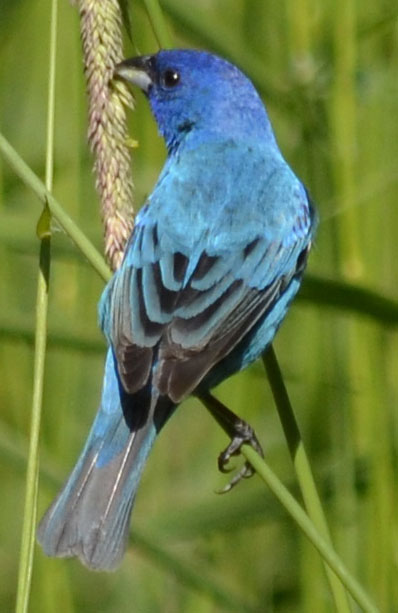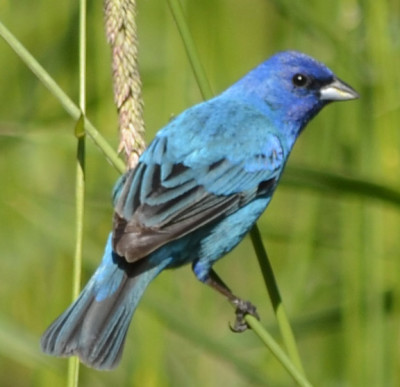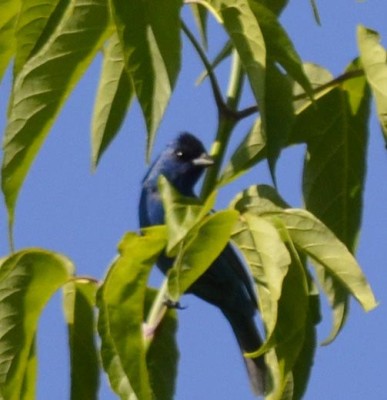While pacing slowly and quietly around the maintenance loop road at Riverwood Conservancy stalking the elusive Blue Bunting, I wondered: what do they eat? Since the Indigo Buntings were ignoring their press releases that said they like to perch high and sing non-stop, I figured the next thing I needed to know was where they might lurk for lunch.
Of course the bird guide I had with me at the time didn’t list such useful information. It was all about identifying birds that were sitting there squawking right in front of you. Looking at the sturdy triangular bill gave me some ideas though. Often beaks like that are for seed eaters. Goldfinches and cardinals have short strong bills, for example.
Living Proof of What Indigo Buntings Eat
Of course that was when I walked around the corner and, scanning the scene ahead, froze. For there he was. The gorgeous male blue Indigo Bunting was perched on the very tall stalk of some type of grass, feeding. I guess I now know that seeds make up at least part of their diet!
For almost three minutes, he steadily fed while I stealthily shot photos. I didn’t try to move too close or too fast. For one thing, I try to avoid interfering too much in the lives of wild things. If he had to fly just because of me, he would be wasting energy unnecessarily (I have no interest in having Bunting Pie for supper) and he would also not likely return to feed for quite a while thus losing any benefits this particular type of seed might offer. (This type of grass is not common in that area.)
So I never got a “super close up” photo. But I did get to enjoy the experience. I find watching natural behaviour rewarding in itself.
Later at home, I confirmed that Buntings eat not just seeds but also insects, fruit such as berries, and even tree and bush buds in the spring, according to AllAboutBirds.org.
Blue Becomes Black When Sunlight Fades
When he did fly, he landed near the top of a small (maybe 5 metres tall) tree. As you can see, although he’s visible, he sure doesn’t look the same. The blue colouring requires full sun to really shimmer. It made the minutes watching him perched on the grasses even more gloat-worthy.
I’m very glad I learned there are Indigo Buntings living near Toronto. While I don’t intend to deliberately hunt for them any more this year, I will certainly welcome any chance encounters during my rambles. And I like knowing they are out there, busily eating seeds and perhaps perching on the tree tops to sing.
Related Reading
Join In
Have you seen a burst of electric blue dart across your yard? Are Indigo Buntings a staple of your back yard bird watching or a piquante accent? Please share your experiences with a comment.



